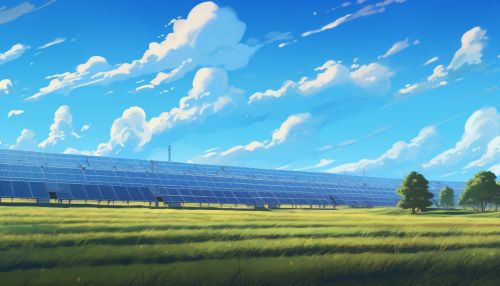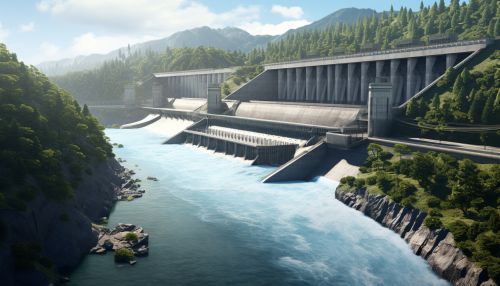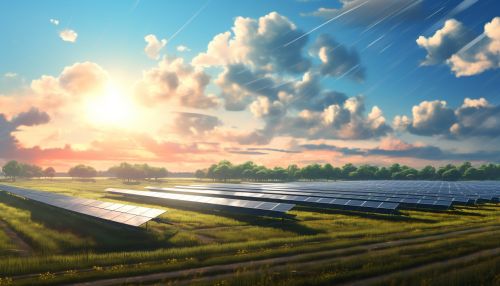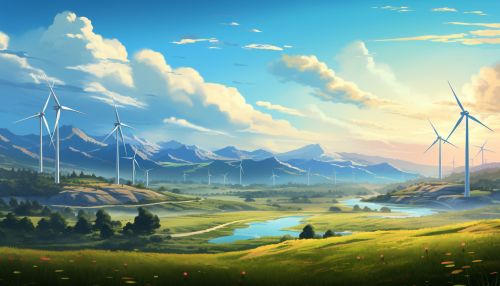Renewable Energy
Introduction
Renewable energy is energy that is collected from resources which are naturally replenished on a human timescale, such as sunlight, wind, rain, tides, waves, and geothermal heat. Renewable energy often provides energy in four important areas: electricity generation, air and water heating/cooling, transportation, and rural (off-grid) energy services.


History and Development of Renewable Energy
The concept of renewable energy is not new. For centuries, people have harnessed the power of the wind, sun, and water for their energy needs. The first use of renewable energy in human history is probably the use of firewood as a fuel source. The use of wind and water power for grinding grain and pumping water dates back to the ancient Greeks and Romans.


Types of Renewable Energy
There are several types of renewable energy sources that are commonly used today. These include:
Solar Energy
Solar energy is the most abundant energy resource on earth. It is derived from the sun's radiation and can be converted into thermal or electrical energy. Solar energy is harnessed using various technologies such as solar heating, photovoltaics, solar thermal energy, solar architecture, and artificial photosynthesis.
Wind Energy
Wind energy is harnessed by converting the kinetic energy of the wind into mechanical energy. This mechanical energy can then be used to power generators to produce electricity. Wind turbines are the most common method of harnessing wind energy.
Hydroelectric Energy
Hydroelectric energy is generated by the movement of water. This can be through the use of dams or through the use of tidal and wave energy systems. Hydroelectric energy is a reliable and consistent source of power, as water is a constant resource.


Geothermal Energy
Geothermal energy is derived from the heat within the earth. This heat can be harnessed to produce electricity or to heat buildings. Geothermal energy is a constant and reliable source of power, as the heat within the earth is always present.
Biomass Energy
Biomass energy is derived from organic material, such as plants and animal waste. This material can be burned to produce heat, or it can be converted into biofuels such as ethanol and biodiesel.
Benefits of Renewable Energy
There are numerous benefits to using renewable energy sources. These include:
- Environmental Benefits: Renewable energy sources produce little to no greenhouse gas emissions, reducing their impact on climate change. They also have a smaller impact on air and water quality than traditional energy sources.
- Economic Benefits: Renewable energy sources can be cheaper than traditional energy sources, particularly when considering the long-term costs of fuel, maintenance, and environmental impact. They can also create jobs and stimulate economic growth.
- Energy Security: Renewable energy sources are often decentralized, reducing the risk of energy supply disruptions. They can also reduce dependence on foreign oil and increase energy independence.


Challenges and Criticisms of Renewable Energy
Despite the many benefits of renewable energy, there are also challenges and criticisms. These include:
- Intermittency: Many renewable energy sources, such as wind and solar, are intermittent, meaning they are not always available. This can make it difficult to rely on them for constant power supply.
- Cost: While the cost of renewable energy technologies has been decreasing, it can still be more expensive than traditional energy sources. This is particularly true for technologies that are still in the early stages of development.
- Environmental Impact: While renewable energy sources have a smaller environmental impact than traditional energy sources, they are not without their own impacts. For example, the construction of large wind farms can have an impact on local wildlife, and the production of biofuels can lead to deforestation.
Future of Renewable Energy
The future of renewable energy is promising. With advancements in technology and an increasing awareness of the need to transition to cleaner energy sources, the use of renewable energy is expected to increase. In addition, policies and incentives aimed at promoting the use of renewable energy are being implemented around the world.


See Also
References
1. "Renewable Energy – An Overview". World Nuclear Association. Retrieved 2021-09-20. 2. "Types of Renewable Energy". National Geographic. Retrieved 2021-09-20. 3. "Benefits of Renewable Energy". U.S. Department of Energy. Retrieved 2021-09-20. 4. "Challenges and Criticisms of Renewable Energy". Nature Energy. Retrieved 2021-09-20. 5. "The Future of Renewable Energy". International Renewable Energy Agency. Retrieved 2021-09-20.
